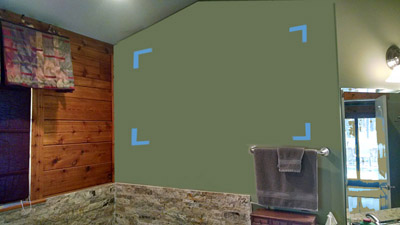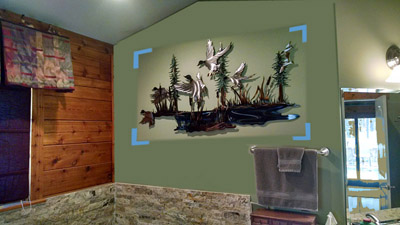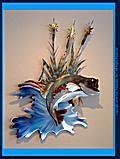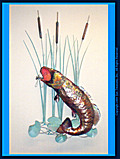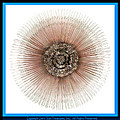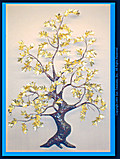How To Get Started
"I have a huge wall. I have seen several metal wall sculptures that I like, but I don't know how to get started. What should I do? " This is a very typical question asked by people seeking to decorate their walls.
We offer the following advice. First, get an idea of how the size of the piece will look on the wall. A good way to do this is to use blue painter's masking tape to mark off the area on the wall where you are considering placing the art work (the tape will come off easily without harming the wall paint). Stand back and take a look at the wall. Does that size look pleasing to you? Should it be moved a bit? This is a quick and inexpensive way to try a few alternatives. You will notice that the higher up on the wall that you place the metal sculpture, the smaller it will appear, so take that into account as you plan your wall.
Below is an example of how the tape was used to mark the edges of the rectangle that would enclose Ken Scott's Hunter's Dream. If you would like to learn more about this sculpture, click on Hunters Dream.
Next, consider the colors in your room and how the wall sculptures will blend in. It is not necessary to exactly match certain colors in the room, although some designers prefer to color-coordinate wall decorations. Often, the natural colors of wall sculptures will blend in nicely with a wide range of colors. Natural copper is a very versatile color, as is brass. Monochrome can provide drama, or a mixture of rich colors can blend in nicely. Below are a few examples of colors acheived by metal artists and how they can affect the look of a wall sculpture.
Ken Scott's Bass with Reeds offers a lot of flexability with its silvers, blues and golden browns. Heat treating and grinding create reflective colors and surface texture.
Max Howard's approach to the same subject, but using different techniques and metals, renders soft greens and warmer browns in his "Bass and Cattails".
The classic sunburst created by Bovano of Cheshire blends the natural color of the copper plated rays with a molten bronze center, a versatile combination that will fit in well with a host of interior colors.
Another versatile combination can be found in Max Howard's Chinese Maple Tree that contrasts the copper patina of the trunk to highly reflective polished brass leaves.
Finally, trust your instincts. Art is emotional, and metal wall art is no exception. Your emotional response is every bit as important as your logical response. Viewing multiple sculptures quite often leads to indecision, but we have found that the sculpture you were initially drawn to is usually the best choice.
Follow the links below for additional information and "how to" suggestions.
